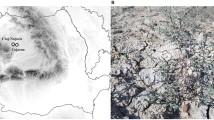Summary
The effect of salinity on the ionic balance and the hexitol content of the halophyteP. maritima L. and the nonhalophytesP. major L. ssp.major, P. lanceolata L., andP. media L. was studied in a culture experiment. In response to salt application the nonhalophilous species increased their internal electrolyte content to a considerably greater extent at high transpiration thanP. maritima. Excessive uptake of Cl and SO4 following salt-treatment was in most cases compensated by a decline in the total organic anion content in all species under investigation. Na was strongly accumulated in the shoots ofP. maritima when subjected to salt-stress, while the nonhalophytic species tended to exclude this ion from leaf tissue enhancing Mg-uptake for charge balance. Acyclic polyhydric alcohols (sorbitol and mannitol), the dominant soluble carbohydrates in allPlantago species studied, increased, with one exception, in all plants under saline conditions. The results indicate marked physiological differences between the halophyteP. maritima and the nonhalophytic members of the genusPlantago in their reaction to salinity being perhaps partially responsible for differences in the degree of salt tolerance.
Similar content being viewed by others
References
Ahmad I, Larher F and Stewart G R 1979 Sorbitol, a compatible osmotic solute inPlantago maritima. New Phytol. 82, 671–678.
Ahmad I, Wainwright S J and Stewart G R 1981 The solute and water relations ofAgrostis stolonifera ecotypes differing in their salt tolerance. New Phytol. 87, 615–629.
Albert R 1982 Halophyten.In Pflanzenökologie und Mineralstoffwechsel. Ed. H Kinzel. Verlag Eugen Ulmer, Stuttgart.
Bernstein L, Ehlig C F and Clark R A 1969 Effect of grape rootstocks on chloride accumulation in leaves. J. Am. Soc. Hortic. Sci. 94, 584–590.
Blom C W P M 1976 Effects of trampling and soil compaction on the occurence of somePlantago species in coastal sand dunes. I. Soil compaction, soil moisture and seedling emergence. Oecol. Plant. 11, 225–241.
Epstein E and Jefferies R L 1964 The genetic basis of selective ion transport in plants. Annu. Rev. Plant Physiol. 15, 169–184.
Erdei L and Kuiper P J C 1979 The effect of salinity on growth, cation content, Na+-uptake and translocation in salt-sensitive and salt-tolerantPlantago species. Physiol. Plant. 47, 95–99.
Erdei L, Stuiver C E E and Kuiper P J C 1980 The effect of salinity on lipid composition and on activity of Ca2+- and Mg2+-stimulated ATPases in salt-sensitive and salt-tolerantPlantago species. Physiol. Plant. 49, 315–319.
Flowers T J 1975 Halophytes.In Ion Transport in Plant Cells and Tissues. Eds. D A Baker and J L Hall. pp. 309–334. North Holland, Amsterdam.
Flowers T J, Troke P F and Yeo A R 1977 The mechanism of salt tolerance in halophytes. Annu. Rev. Plant Physiol. 28, 89–121.
Freijsen A H J and Van Dijk A 1975 Differences in growth rate and salt tolerance between varieties of the halophyteCentaurium littorale (Turner) Gilmour, and their ecological significance. Acta Bot. Neerl. 24, 7–22.
Gorham J, Hughes L I and Wyn Jones R G 1981 Low-molecular-weight carbohydrates in some salt-stressed plants. Physiol. Plant. 53, 27–33.
Greenway H and Munns R 1980 Mechanisms of salt tolerance in nonhalophytes. Annu. Rev. Plant Physiol. 31, 149–190.
Jacoby B 1964 Function of bean roots and stems in sodium retention. Plant Physiol. 39, 445–449.
Jefferies R L, Rudmik T and Dillon E M 1979 Responses of halophytes to high salinities and low water potentials. Plant Physiol. 64, 989–994.
Königshofer H 1981 Stoffwechselphysiologische Untersuchungen an Plantago-Arten unter besonderer Berücksichtigung ökologischer Aspekte. Phil. Diss. Universität Wien.
Lambers H, Blacquière T and Stuiver C E E 1981 Interactions between osmoregulation and the alternative respiratory pathway inPlantago coronopus as affected by salinity. Physiol. Plant. 51, 63–68.
Läuchli A 1976 Genotypic variation in transport.In Encyclopedia of Plant Physiology. New Series, vol. 2, part B. Eds. U Lüttge and M Pitman. Springer Verlag, Berlin-Heidelberg-New York.
Läuchli A 1976 Symplasmic transport and ion release to the xylem.In Transport and Transfer Processes in Plants. Eds. I F Wardlaw and J B Passioura. Academic Press, London, New York.
Läuchli A 1979 Regulation des Salztransportes und Salzausschließung in Glykophyten und Halophyten. Ber Deutsch. Bot. Ges. 92, 87–94.
Oertli J J 1968 Extracellular salt accumulation; a possible mechanism of salt injury in plants. Agrochimica 12, 461–469.
Popp M and Kinzel H 1981 Changes in the organic acid content of some cultivated plants induced by mineral ion deficiency. J. Exp. Bot. 32, 1–8.
Ramati A, Liphschitz N and Waisel Y 1979 Osmotic adaptation inPanicum repens. Differences between organ, cellular and subcellular levels. Physiol. Plant. 45, 325–331.
Rozema J 1976 An ecophysiological study on the response to salt of four halophytic and glycophyticJuncus species. Flora 165, 197–209.
Rush D W and Epstein E 1976 Genotypic responses to salinity. Differences between salt-sensitive and salt-tolerant genotypes of the tomato. Plant Physiol. 57, 162–166.
Sagar J R and Harper J L 1964Plantago major, Plantago lanceolata andPlantago media. J. Ecol. 52, 189–221.
1971 Salt tolerance in the wild relatives of the cultivated tomato: responses ofLycopersicon esculentum, L. peruvianum andL. esculentum minor to sodium chloride solution. Aust. J. Agric. Res. 22, 631–638.
Author information
Authors and Affiliations
Rights and permissions
About this article
Cite this article
Königshofer, H. Changes in ion composition and hexitol content of differentPlantago species under the influence of salt stress. Plant Soil 72, 289–296 (1983). https://doi.org/10.1007/BF02181968
Issue Date:
DOI: https://doi.org/10.1007/BF02181968




